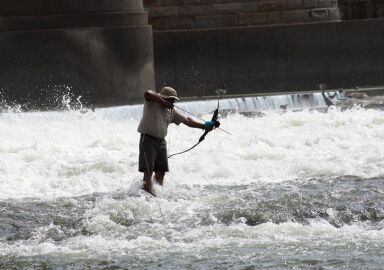Bighead Carp
Bighead carp is a big, plankton-feeding fish from Asia; introduced well beyond its original range, it’s a dangerous invasive to some, challenging sport fish to others.
View 2 listings
2
listings
US $105
price starting from
2
countries
842km
to the nearest trip
Where and When?
The natural habitat of the bighead carp is from eastern China eastwards up to the Amur River on the Russian border. It is a freshwater species but can survive in brackish waters. Bighead carp are one of the most common species in aquaculture, and they are intensively used for the purpose in more than 70 countries. The species was also introduced to the USA, South America, Europe, Egypt and Australia, with the intent to control aquatic plants. In the USA it was introduced to the Mississippi River and is now firmly established there, as well as in many other areas where it has subsequently spread.
If it can spawn in an area, it is almost impossible to remove it after an introduction and, as an adult, it has few real predators. Bighead carp can be caught throughout the year but feed and move most readily, and in shallower waters, in summer. Most fishing is carried out in fairly large rivers, dams or lakes in daylight in fairly deep waters.
About Bighead Carp
The bighead carp (Hypophthalmichthys nobilis) is a member of the carp family. It is not a sport angling species in its natural range but is attracting some attention in areas where it has been introduced. Bighead carp have large, scaleless heads with a big mouth, and small eyes that sit low on the head. These fish have a fairly elongated body, usually of a mottled grey. The maximum size attained is about 1.47 m (4.7 ft.) and 40 kg. (88 lbs.) but the mean size usually caught is nearer 60 cm (2 ft.). They mature at 2-3 years and can live for about 20 years.
Bighead carp feed naturally almost exclusively on zoo- and phyto-planktom that they usually take from the substrate or, occasionally, from the water surface. They can breed only in large slow-moving river and, prior to spawning, migrate far upstream during floods. Eggs are laid in deep areas and drift downstream for about two days before hatching and developing in backwaters. Adult females can lay around 300 000 eggs per spawning session.
How to Catch?
Outside its natural habitat, bighead carp are often considered a problematic invasive species by authorities, who ideally aim to eradicate them entirely. However, containment and population control are more realistic goals, along with finding ways to utilize and diminish their numbers. Regulations often mandate that any caught bighead carp must be killed.
Sport fishing for bighead carp, although limited, includes methods like bowfishing, light tackle bait fishing, and spinning with spoons featuring large treble hooks. In certain areas, "snagging" with a weighted large treble hook is permitted. A growing number of sports anglers accept the challenge of landing this shy, large fish. Despite their reputation as a challenging catch due to their shyness and size, a growing number of sport anglers are drawn to these strong fish. Employing medium spinning rods with light terminal tackle, small hooks, and often much patience, anglers can enjoy successful fishing experiences. Preferred techniques include using floats, simple bottom fishing, and baits such as young soft peas, sweetcorn, bread, or worms.
Exciting opportunities arise in rivers, especially below dams where bighead carp tend to congregate. Here, if legally permissible, anglers can engage in snagging or bow fishing, or even spinning with small heavy lures and big hooks. Although bighead carp aren’t predatory, they apparently swipe at such lures, and so hook themselves.Landing a sizeable bighead carp can be quite an achievement, and their flesh is prized for its high quality and taste.






